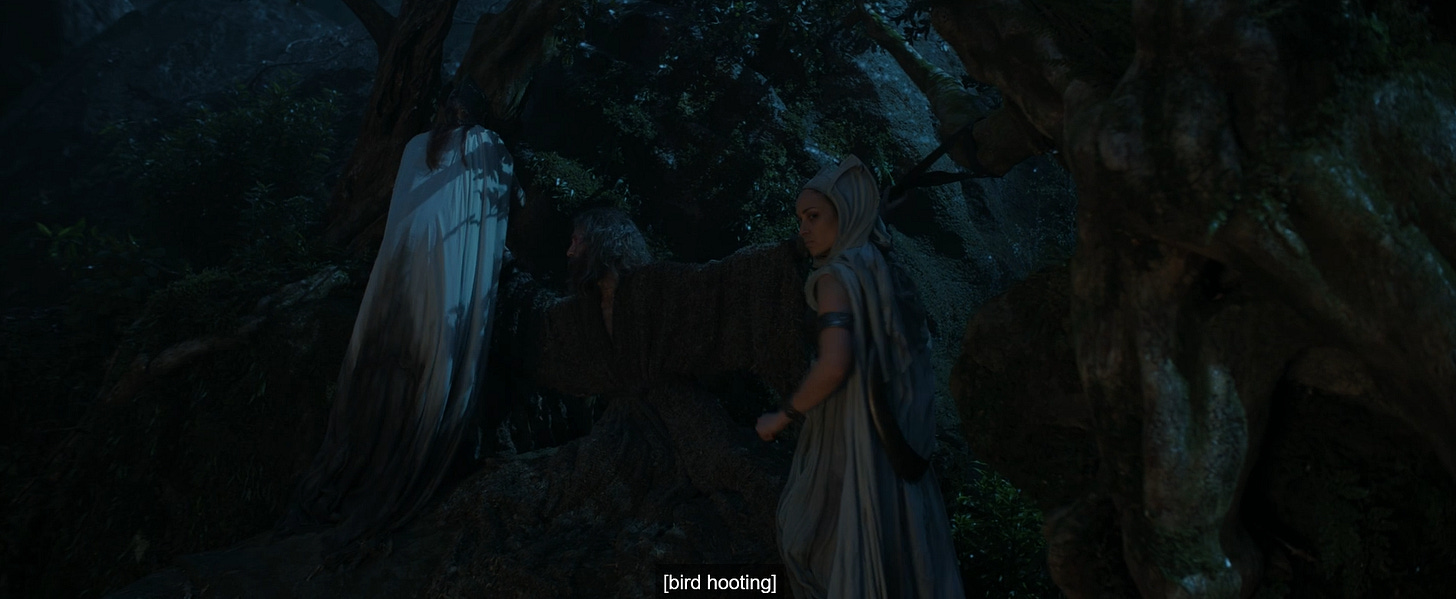As soon as the Harfoots first appear in the show The Lord of the Rings: The Rings of Power, we are given a great deal of insight into their culture. We see a few Harfoots disguised amongst the grasses, spying on two large hunters with ornamented antlers, and successfully remaining unnoticed.

In the field of behavioral ecology, this tactic is known as ‘masquerade’—“preventing recognition of an animal by resembling an uninteresting or inanimate object in the environment, such as a leaf or stick”.
This and similar camouflage tactics are common both across species and throughout many human societies, as I wrote about in my paper in the journal Human Nature on disguises and the origins of clothing.

Anthropologist Alanson Skinner writes that among the Ojibwa of Canada, “The [war] party was always preceded by scouts…While in service they wore headdresses of grass to conceal them the better when they lay flattened out on the prairie.” Other North American tribes such as the Gros Ventre were also known to have followed this practice.

Once the hunters leave, a Harfoot blows a kind of whistle or flute to signal to their compatriots things are all clear.
As I discussed in a previous post, the use of musical instruments for signalling purposes is common across many forager societies.
Less than a minute into their first appearance on the show and we have already learned a great deal about them, with the focus on some very credible cultural details. The Harfoots are a small people—both physically, and in terms of their ‘social-scale’. In a world with many large dangers they have to be clever. They conceal themselves in plain site with their masquerades and they use musical instruments to communicate in plain hearing.
After the instrument is blown we see Harfoots in their village emerging from hiding places and removing masquerade coverings from their carts.
It is common for nomadic people at risk of attack from enemies to conceal their temporary settlements when possible. In the early 20th century, explorer Vilhjalmur Stefansson noted that the campsites of the Akuliakattagmiut of Canada were commonly chosen on hilltops with a good surrounding view of the country to guard against sneak attacks from enemies. They made sure there were many boulders and stone slabs around the site as well, because the caribou skins they used for their tents blended in well with such a backdrop. Stefansson writes that,
A dozen tents are often so artfully pitched that the men and dogs moving about them can be seen at a greater distance than the tents, while an Indian lodge or a white man's tent can usually be seen four times as far as could men standing around them. In August, 1910, our camp was for a few days located a quarter mile across a small lake from an Eskimo camp of some seven tents. Though this camp was on the skyline as seen from ours, we had the greatest difficulty in making it out without the use of glasses, so little did a tent on the skyline differ in shape and color from a boulder on the skyline. Looking from their camp to ours the small details of arrangement could easily be made out. [emphasis added].
One cool visual detail that recurs across multiple episodes of The Rings of Power is the way the kinds of vegetation the Harfoots use to conceal their carts appropriately change depending on the environment they’re in.
Another instrument we see the Harfoots use later is a whistle which mimics an owl hooting…
…and which they use as a lure to draw out their adversaries.
Mimicking the sound of another species as a lure is another cross-culturally common practice, check out our paper led by Cody Moser on aggressive mimicry as a hunting tactic and its importance in human evolutionary history.
Although in this case it didn’t exactly make a lot of sense to me—why would the priestesses respond to a random bird call? If the mimic is to function effectively as a lure it should be a sound the target can be expected to respond to, which is why in nature the mimic tends to imitate the intended prey species, who is liable to move towards a potential mate, or ally, or competitor. Perhaps there is a Tolkien lore explanation here about birds sometimes being spies or something, and maybe the priestesses were worried about that. But really, if the Harfoots’ goal was to draw them out, and the priestesses were looking for them already anyway, simply yelling would probably work better.
Beyond these dramatic efforts towards concealment and signalling with instruments, what else do we learn about the Harfoots throughout the show?
Much of the commentary about the Harfoots I’ve seen online has been quite negative. “The Harfoots are evil,” says a post with over 1,800 ‘upvotes’ in a Lord of the Rings subreddit. “We Need to Talk about the Heartless Harfoots of Rings of Power,” according to a headline at Paste Magazine. “Is it just me, or are the harfoots kind of horrible?” questions another headline, this time at The Daily Dot.
Fundamentally, there are two main complaints: the Harfoots make jokes about members of their community who died, and they are quick to abandon to die those who fall behind.
Before I argue that these complaints, while factually true, are misguided as criticisms of the show and Harfoot culture, let me acknowledge what I think is one useful point critics have made.
Both the critics at Paste and The Daily Dot point out that after the healthy adult man Largo breaks his ankle, this is treated almost as a kind of death sentence, and no one seems willing or able to help pull his cart. Generally, in nearly any society you can expect to have at least some risk buffering systems to deal with temporary shortfalls and setbacks such as this.
This is one reason why hunters tend to share big game widely across forager societies, because hunting is commonly a high-variance activity—I share when times are good for me and bad for you, and you do the same. Particularly when it comes to what should be a temporary illness or injury for an otherwise healthy and productive adult, the Harfoots should probably have some practices to deal with this kind of thing.
With that said, people in nomadic societies by the necessities of their lifestyle may have to deal with some very difficult circumstances. Consider this description from anthropologists Kim Hill and Ana Magdalena Hurtado of the Ache hunter-gatherers of Paraguay,
In the forest, when the Ache were highly mobile, a cruel fate fell upon anyone who could not keep up with the band. Many were simply left behind and never seen again. Others were left on trails near the houses of Paraguayans in the hope that these “enemies” would take pity on and care for the disabled. Still others were buried alive, in order to save them the hideous fate of being devoured by vultures while still conscious. Although such events were relatively rare before contact, they were extremely common during the period of contact when epidemics swept rapidly through the population. Old and sick individuals were simply left behind. Relatives often broke wide, well-marked trails, hoping that their loved ones would catch up later, and sometimes they did, even managing to crawl on their hands and knees from one camp to another until they were able to walk.
Despite this rather harsh treatment of the disabled, occasional examples of great sacrifice are also found. Several blind individuals were led around for years by others who helped them follow the band’s trail (all, however, were ultimately abandoned in times of stress). One boy who had lost his leg below the knee from a snakebite was carried piggyback by his father and other relatives. (He was later left with Paraguayans at first contact.) Older children who couldn’t walk for whatever reason were sometimes carried by their parents for years (again, all were ultimately abandoned, however).
Note both abandonment, particularly in times of severe stress, but also great self-sacrifice and care. In one case, laced with what seems to be a sense of dark humor among the group involved, they write that,
A middle-aged man was left behind because he was too sick to keep up. He was so weak that vultures came right down to the branches just above his head to wait for him to die. He managed to drive away the vultures and recovered from his illness. When he returned to his band they gave him the nickname “Vulture Droppings” because he was covered with feces from the birds who had perched above him. [emphasis added].
Among the Tiwi hunter-gatherers of Australia old women unable to keep up with the band were sometimes buried alive.
While the critical complaints about the theme of abandonment are somewhat understandable, albeit quite parochial, the criticisms of Harfoot sense of humor are just funny. “What the hell is up with the Harfoots? Laughing about a man getting killed by bees because he was an idiot?” asks the Redditor who said the Harfoots are evil.

Standards of humor vary across cultures, individuals, and social contexts. The Harfoots live a challenging nomadic existence in a harsh world occupied by many powerful beings. Slowing down the caravan for one risks dooming them all, and the difficulties their community faces promotes a dark and somewhat melancholic sense of humor. It’s no coincidence that the jokes critics are complaining about mostly occur during what appears to be a kind of funeral rite in episode 3, where they remember and recite the names of those who fell behind. The jokes are part of how the Harfoots mourn.
Naturally, The Rings of Power is a work of fiction and the Harfoots are not real, and as with the world building in pretty much anything you can surely point to numerous ‘unrealistic’ behaviors and other problems with the depiction if you want to go through the tedium. Overall though I was impressed with many of these little details that for me went a long way towards building a credible fictional culture rooted in authentic but underexplored human behaviors.
Related posts: The Northman, the decline of western civilizations, and the rise of 'Western Civilization', Disguises and the Origins of Clothing, Some Uses of Musical Instruments in Hunter-Gatherer Societies, Diss songs.













You know, when I watched the first two episodes, I wondered if you would share your thoughts. It's unfortunate that the writing team seems to have studied and understood hunter-gatherer lives better than, you know, how to write a compelling screenplay. That's why I only watched two episodes. But I really enjoyed this, so maybe Amazon should hire you instead?
this is full nerd